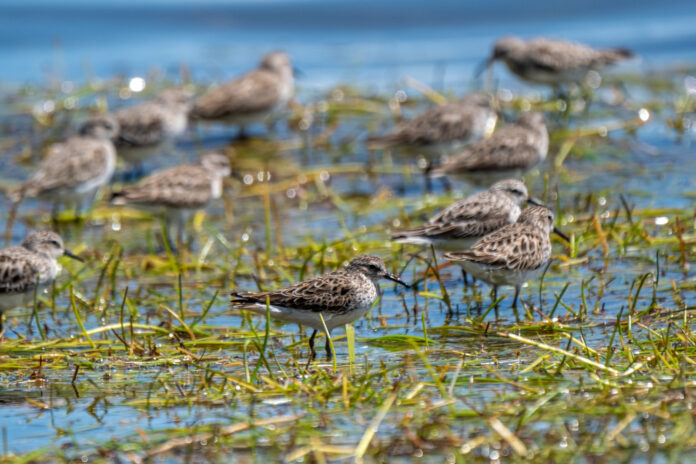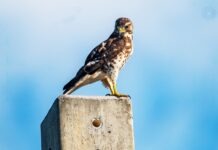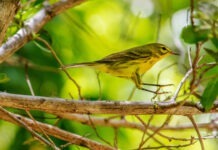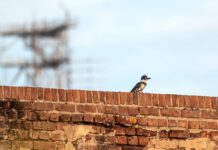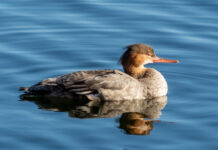I spent most of the morning driving around the Lower Keys looking for ducks, because some days you just want to see a duck. I didn’t find any, but I did see some other things. On Big Torch Key, an early-returned gray kingbird on the phone line seemed to be staking out turf a solid month before the rest of his cohorts return. On Cudjoe, down at the end of Blimp Road, a guy carrying a staff and wearing an olive drab kilt and a matching olive drab wizard hat gestured that he would like me to stop and give him a cigarette. Or maybe a joint. I’m not sure. I didn’t stop.
I made it up to Big Pine, where I failed to find any peacocks. This has happened multiple times, the not-seeing-peacocks thing, despite people who live in the allegedly peacock-rich neighborhoods telling me it’s impossible to miss them. At the Blue Hole, the gator was hiding, tail out, under the observation deck, like a cat under a couch. Near Port Pine Heights I drove at an appropriately slow speed past a Key deer and wondered how I’d never noticed that stripe of dark fur that runs up the back of their necks.
I decided I didn’t have time to drive out to No Name Key, because it always takes forever and on my last couple trips there hadn’t been much to see, birdwise. But then muscle memory kicked in, using my generally distracted nature to choose sides between the brain’s directives and the heart’s unuttered wants. I found myself on autopilot, driving down Watson Boulevard, past the No Name Pub and then over the No Name Bridge, very carefully, as it was full of families casting fishing lines.
I always get a small, unsettling twinge when I drive down that road, thinking about the woman, or at least the fact of the woman, who was found stabbed and horribly mutilated on No Name Drive in the late ’80s, just before I moved to the Keys. The crime looks less and less likely to be solved with every passing year. But I try to leaven that feeling with the thought that wretched acts of humans should not dominate our thoughts about a place. A landscape does not carry guilt.
Though my last couple of trips haven’t been great, I’ve seen a lot of good birds out there – mangrove cuckoos, white-eyed vireos, and my first Wilson’s phalarope, swimming in a circle in one of the ponds. And you have to love a place whose name is a denial that it has a name.
I parked at the end of the road, slung my camera and binoculars over my shoulder, and weaved between the huge chunks of quarried oolite that keep people from driving into the water.
It’s always amazing when you find a bit of open shoreline in the Keys, even when you know it will be there. The world opens up. There’s a lot more light. You remember the crazy fact that islands are totally surrounded by water.
Looking out toward the horizon, I continued my streak of ducklessness. The small dock to the north, usually a reliable spot for royal terns, and sometimes shorebirds, was empty. My birding fruitlessness streak at No Name continued.
But then I heard all the twittering. Off to the south, about 30 yards in front of me, were several bands of sargasso weed that grew darker in color the farther they were from the water.
People talk a lot of smack about sargassum, but it is a crucial part of the Keys ecosystem, and many other aquatic and littoral ecosystems. Fish depend on it. Crabs depend on it. Birds depend on it. Ask any fisherman or biologist. The huge mass of sargassum that may come this way this summer might be a different story, as too much of anything is rarely good, but it’s pretty eye-rolling to hear people complain about the smell and other effects when it hasn’t actually happened yet.
The twittering was coming from a flock of 100 or so shorebirds moving around on the sargassum bands in front of me in something of a feeding frenzy. They were all one of two species – ruddy turnstones or least sandpipers, the ruddies about twice the size of the leasts. Most of them were on the weeds that had been pushed up onto land, but about a third of them were out walking across the floating seaweed, like loggers riding a raft of logs down a river.
Hopping among all of them, with the vertical leap of Michael Jordan with a rocket pack on the moon, were these white things, about the size of my pinkie nail, arcing through the air like just-popped kernels of corn. They were pale, whitish, almost translucent. I’d always thought of them as sand fleas, but later research (which included texting the Nature Conservancy’s Keys eco-guru Chris Bergh) would show them to be isopods – small invertebrate crustaceans defined by their four mouths and 14 legs. If that was what the shorebirds were eating, it was impressive when isopods moved that fast and that dramatically, though the shorebirds could have been feasting on other, slower moving prey items.
In an instant, all the birds were gone, the flock panicking and acting as one entity, shooting out over the water, then toward the dock, before doubling back, and landing again, though staying mostly on the outer, floating edges of the sargassum.
I’m not sure what set them off. I don’t think it was me, because I had been there for a little bit and hadn’t moved. But you have to wonder how the decision for a flock to erupt like that gets made, how the information is communicated, how it is understood by all the birds so quickly. Is it the jumpiest birds that set them off? Is there a leader bird whose jumpiness is trusted by the flock? An executive council of jumpy birds? How can something that happens so quickly be considered decision-making?
Do the ruddy turnstones trust the least sandpipers? And the sandpipers the turnstones? What’s the decisional hierarchy? Who makes the decision, and how does the decision get made, when they all turn, seemingly simultaneously, in midair?
There are, of course, a lot of theories on this in the ornithology world. Visual signaling, audio signaling and so forth. Some have suggested a kind of telepathy among members of the flock. None of this has really been figured out yet. Part of me thinks it never will be.
The birds took off again a few minutes later, and I moved to the edge of the sargassum, sat down and waited for them to come back. Which they did. They went through the cycle several more times – panic, flee, return.
I took a few pictures, but mostly I just watched them, happy to find a little mystery at the end of the road.















